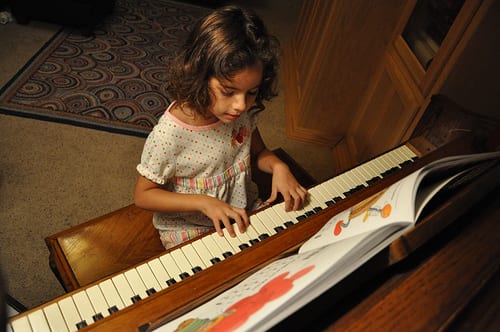 Taking piano lessons is an exciting experience – for students and parents alike! Moms and Dads, your support is an important part of the equation, and it begins with setting the stage before lessons even start.
Taking piano lessons is an exciting experience – for students and parents alike! Moms and Dads, your support is an important part of the equation, and it begins with setting the stage before lessons even start.
We recently came across a fantastic list on pianist Elissa Milne‘s blog, detailing the to-do’s before your child’s first lesson. Here is an excerpt from the article:
1. Buy a piano. This may or may not seem like a no-brainer to you. In case it’s not, let me explain. Your child will not make progress without a piano at home with which they can practice between lessons. So until you have a piano don’t bother organizing to take piano lessons. Unless your goal is to pay for really expensive babysitting.
2. Put the piano in a part of the house that isn’t a. lonely and/or b. where the only TV is. Two of the biggest reasons children don’t end up practicing is because they’re either lonely in the glummest/most distant room of the house or because everyone else wants to watch the television and the piano is in the same room. Having the piano hidden away communicates that the piano is not something normal or useful; having the piano and TV competing for acoustic space is just asking for conflict in your family.
3. If you have an acoustic piano, keep it tuned! This is more of an administrative burden than it is a major expense (you need to find a piano tuner, book them up, and then be at the house while they tune the piano), but if your piano is out of tune your child(ren) will find playing the piano far less pleasant, and you won’t enjoy hearing the piano played all that much either.
4. Have the piano in your house for months – even years – before your child begins lessons. This is about developing a sense of the everyday about the instrument (the piano is a part of normal life) as well as allowing the child to explore the instrument quite thoroughly prior to lessons beginning. To which end….
5. Encourage your child to play around with the piano prior to beginning lessons. You can’t break a piano by playing it, and your child will develop a sense of familiarity with the layout of the keys (black notes in groups of 2 and 3 placed between white notes) and the way the keys make sounds (high sounds towards the right, low sounds towards the left) as well as different effects the piano can make (softer sounds when you press more gently, sustained sounds when you depress the pedal, etc.). This saves time in the first weeks of lessons and, more importantly, means that your child will have a confidence when being asked to try ‘new’ things on the piano in these first few weeks and months.
Read the rest of the checklist and article here. Great post, Elissa!
You might also like…
– Why Piano Lessons Are Worth It
– Video: 7-Year-Old Piano Prodigy at Work
– Music, Math and More: How Do They Relate?
Photo by egarc2
Suzy S.
